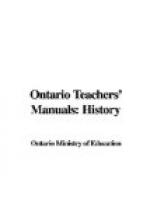St. Valentine grew old, loving and beloved, never dreaming that he had found his great thing. When the simple monk died the whole countryside mourned, and hundreds came to look for the last time on the quiet face in the rude coffin.
A great duke walked bare-headed after that coffin, and one of the most noted brothers of the church spoke the last words of blessing to the weeping people.
After his death, it was remembered how sweet had been his little gifts, and the villagers said: “Let us, too, give gifts to our friends on the good Valentine’s birthday.” So ever since has the pretty custom been carried out, and on St. Valentine’s day we send our friends little tokens of remembrance to say we love them.
THE FIRST THANKSGIVING
It is nearly three hundred years since the first Thanksgiving Day. Though we have even more to be grateful for, I think that there are not many of us who feel quite so thankful as the little handful of people who set apart the first Thanksgiving Day.
There were not very many of them, just one little village in a big forest land, and by the edge of a great ocean. Here, on the map, is where they lived. It is on the north-eastern shores of the United States and is called Plymouth. The people I am telling you about gave it that name when they came to it, nearly two years before they had their first Thanksgiving Day. It was the name of the last town they had seen in England. Here, on the map, is the English Plymouth, and you see what a long trip they had in their little vessel, called the Mayflower, to their new home.
You still wonder why they travelled so far to make new homes for themselves. It was because they wanted to worship God in their own way that they left England. They were not afraid of the long voyage and all its hardships; for they felt sure they were doing as God wished them to do. They arrived safely, too, and built their little village by the sea—the new Plymouth. One of the first buildings they put up was a little log church.
The first year was very hard for everybody. The winter was colder than any they had ever known in England, and their houses were small and poorly built. They could not get any letters or news from their friends in England for many months. Food was not scarce, for there was always plenty of game and fish. But it was such a change from their old way of living that many people became ill, and in the spring there were many graves. But the worst thing about the new land was the Indians. These English people were afraid of them—and with good reason, too, for they were very fierce and sometimes very cruel. They tried not to let the Indians know how few they were, and even planted grain about the graves in the churchyard so that the Indians could not count how many had died.




